
Vedic History and The Flat Earth
Vedic History and The Flat Earth
BY: MAYESVARA DASA
Jan 31, 2019 — IRELAND (SUN) —
Part 1: The Flat-Earth in Mahabharata
In Part 1 of this paper we will look at the flat-Earth concept in the Mahabharata. In Part 2 we will look at the flat-Earth concept in the Ramayana. In today's part 1, we will look at evidence of the history of the flat-Earth from the writings of Sri-Madhvacharya.
In previous papers we have presented the Srimad Bhagavatam's description of the flat Earth (Bhu-mandala) as a great circular plane. We have further argued that the concept of an Earth globe floating in space is not to be found in the cosmological section of Srimad Bhagavatam, nor in any of the other Puranas (histories). Consistent with the Srimad Bhagavatam's description of the Earth circle, is the Vedic history itself which narrates the conquest of this greater Earth plane by Vedic Kings as recently as Yudhisthira and Pariksit (5,000 years ago). We have presented this history in the following four papers:
Part 1, Vedic History Reveals a Greater Earth Plane (Introduction). The paper can be found here
Part 2, Arjuna's Conquest of Jambudvipa and the Empire of King Yudhisthira. The paper can be found here
Part 3, Emperor Pariksit's Conquest of Jambudvipa. The paper can be found here
Part 4, King Ugrasena and Jambudvipa. The paper can be found here
In the above papers we have presented the relevant texts from Srimad Bhagavatam and Mahabharata which describe how the battle for the Earth at the time of Krishna's appearance 5,000 years ago, was not a battle for some supposed Earth globe floating in space, but rather a battle that took place for the entire Bhu-mandala—an entirely different conception of Earth from that of our present understanding. The seven circular islands of the Vedic Earth cover an area of 202,800,000 miles. This vast area is only a portion of the complete Bhu-mandala which has an overall diameter of 4 billion miles. The seven main islands of the Vedic Earth are divided into many smaller continents, islands, seas, and kingdoms, etc., that are home to innumerable living beings and various civilizations—the continents of our known Earth are but one of them.
The apocalyptic events of 5,000 years featuring a universal battle between devas and asuras specifically centered on Jambudvipa, the first of the Earth's seven great dvipas (islands). All the Puranas measure Jambudvipa as 100,000 yojanas (800,000 miles) in diameter. Srimad Bhagavatam (SB 1.12.5) states that King Yudhisthira, who ruled from Indraprastha in ancient India, was Emperor not only of our entire known Earth, but also of this vast area of Jambudvipa (mahi jambudvipadhipatyam ca). Mahabharata also provides additional evidence for King Yudhisthira's rule over the entire Bhu-mandala. For this history of King Yudhisthira and the flat-Earth, see part 2 in the above links. Likewise, in Srimad Bhagavatam 1.16.12, it states that King Pariksit (the successor of Yudhisthira) also became the Emperor of all nine varshas of Jambudvipa. For the history of King Pariksit and the flat-Earth see part 3 in the above links. Today's paper is no more than a confirmation of all that has been said previously, though we do hope that the words of Madhvacharya will tip the balance in favour of the Bhu-mandala concept, particularly among the Vaishnava community.
Where is this greater Earth plane that is described in all of the Vedic literatures? Is the Vedic history of an Earth circle hyperbole or fact? Is the Earth circle (Bhu-mandala) something metaphorical, or something mythological, or something inter-dimensional, or just some imaginary idea dreamed up by ancient story-tellers with a fertile imagination?
Or could it be that there is actually more Earth all around us as the ancient Vedic texts describe?
The answer to this rests on the version of reality that each individual person is prepared to put their faith in. Krishna tells His followers to have faith in His teachings, otherwise one will be befooled:
"Those persons who execute their duties according to My injunctions and who follow this teaching faithfully, without envy, become free from the bondage of fruitive actions.
But those who, out of envy, disregard these teachings and do not follow them regularly are to be considered bereft of all knowledge, befooled, and ruined in their endeavors for perfection." (Bg 3.31-32)
For a member of the International Society for Krishna Consciousness, the question of the Earth's size and shape really comes down to the issue of whether an individual member is prepared to take Krishna's word over that of that of modern 'scientists' and so-called space agencies like NASA. Certainly NASA have produced images of astronauts hovering over a round globe-shaped planet, but are such images real, or just another episode of the great space movie saga that began with the so-called moon landing in 1969? It's not difficult for special effects technicians to create a realistic image of an Earth globe with space craft and astronauts circling around it; indeed, film makers regularly create images of an Earth globe that are indistinguishable from those produced by NASA…

Actress Sandra Bullock as Dr Ryan Stone floating above the Earth globe in the movie Gravity (2013)
…It's just that when people watch television and see 'NASA astronauts' above the so-called Earth instead of Dr Ryan Stone or Superman, they simply assume that the Earth globe and the astronauts are for real and not just part of an on-going movie directed by NASA and cohorts. What is real? In order to know what is real one has to hear from the creator of both reality and illusion (Srimad Bhagavatam 1.1.1). Unless one knows the real nature of the Earth as described by its creator, how can one say whether the images produced by NASA are real or not? Certainly, Srimad Bhagavatam describes a very different concept of the Earth which allows one to at least question the prevailing paradigm. In these papers we hope to better inform the devotee community of the actual nature and history of the Earth as described in Srimad Bhagavatam and related Vedic literature, so that one is better equipped 'to distinguish reality from illusion for the welfare of all' (SB 1.1.2)
In today's paper we will present evidence from Madhvacharya—one of the greatest acharyas in the Vaishnava tradition—who confirms that before performing the great Rajasuya sacrifice in which Yudhisthira was installed as emperor of the Earth, the Pandavas had conquered not only Jambudvipa, but the entire Bhu-mandala (Earth circle). The Earth circle in question is, of course, a radically different concept from the present idea of the Earth as a globe floating in space. Leaving aside for a moment the opinion of so-called 'scientists', atheists, speculators, skeptics, etc., at the very least, for those who claim to be followers of the Vedic teachings, the Puranas (histories) are a spanner in the works for our present understanding of the Earth's history as well as modern scientific ideas regarding a so-called Earth globe and its relation to the sun, moon, and other planets.
We should note that the International Society for Krishna Consciousness is directly connected with Madhvacharya through disciplic succession; indeed, so important is Madhva's position that the Brahma-Madhva-Gaudiya Sampradaya, to which ISKCON belongs, contains his name in the title. For an explanation of Madhva's pre-eminent position, one can see some of Srila Prabhupada's statements here:
https://www.harekrsna.com/philosophy/bmgs/brahma-madhva.htm
Srila Prabhupada writes:
"Lord Brahma is the guru of Narada Muni, who is the guru of Vyasadeva, and Vyasadeva is the guru of Madhvacarya. Thus the Gaudiya-Madhva-sampradaya is in the disciplic succession from Narada Muni." (SB 6:5:22 purport)
The writings of Madhvacharya are important to this question of the Earth's shape, size, and location not only because of his pre-eminent stature as one of the greatest acharyas of India, but also because of his first-hand knowledge of events on Earth at the time of the Kurukshetra war. Although Madhvacharya lived from CE 1238-1317, which is thousands of years after the Kurukshetra war, in several of his writings Madhvacharya reveals himself to be the third incarnation of Vayu (controlling deva of air) stating that he had appeared previously as the famous Hanuman in rama-lila, and as the great warrior Bhima in krishna-lila. Of course, such a claim means nothing to the atheists, skeptics, etc., but for those whose who comprehend (or at least believe in) the spiritual reality, the claim by Madhva is consistent with the remarkable events of his life and teachings, as well as statements from various shastra that confirm his spiritual identity and mission. At the beginning of Mahabharata Tatparya Nirnaya, Madhvacharya declares himself to be the avatar of Vayu:
"The third Avatara of Vayu appearing on earth under the exalted name of Ananda Theertha [a name of Madhvacharya] proceeded to narrate the story of the Supreme Lord (in the subsequent Adhyayas of this work)…" (MahabharataTatparya Nirnaya Adhyaya 3: 9)
At the conclusion of the work, Madhvacharya again writes that he is the third avatar of Vayu having appeared previously as Hanuman and Bhima:
"Purnapragna also known as Anandathirtha [names of Madhvacharya] composed this work as per the orders of Sri Vedavyasa. He is the chief disciple. He has perfect knowledge of Veda, Pancharatra, Brahmasutra, Upanisats, and Itihasapurana…He has composed this work to correctly bring out the purpose of the Mahabharata. He is the third incarnation of Mukhyaprana. His three incarnation's viz. Hanuma, Bhima, Madhwa is mentioned in Veda. He carried the message of Sri Rama to Sita in Hanuman incarnation. He destroyed the evil men in Bhima incarnation and provided right knowledge through this work in the incarnation of Sri Madhwa." (Part 4 of the summary translation of Mahabharata Tarparya Nirnaya by Prof. K.T. Pandurangi)
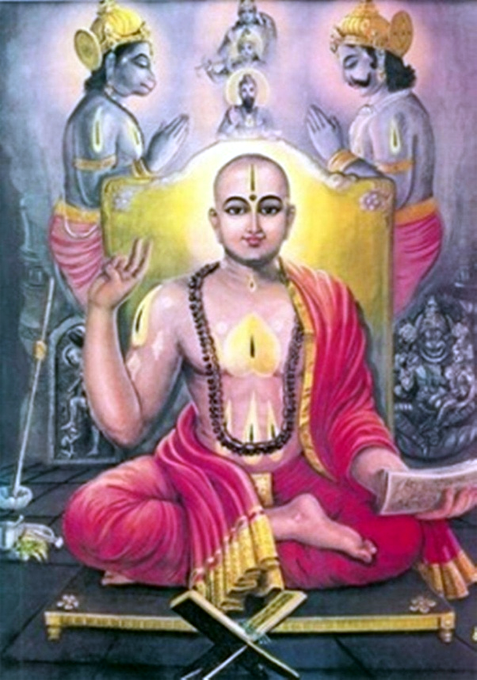
Madhvacharya along with his previous incarnations as Hanuman and Bhima
Madhvacharya's biography reveals a person of superhuman and extraordinary character. In the official biography of Madhvacharya called Sri Sumadvavijaya by Sri Narayana Panditacharya, it is stated that on one occasion whilst on pilgrimage at Kurukshetra, Madhva led some disciples to a spot where they dug up a buried club that he had previously used as Bhima during the Kuruksetra war. He also recounted memories of the battle to his disciples.
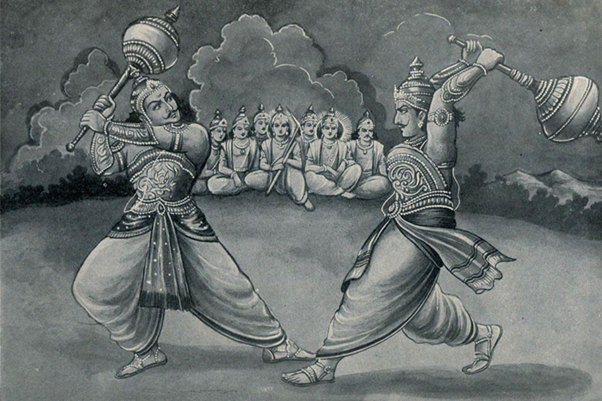
Bhima fighting the evil Duryodhana
The Sri Sumadvavijayaalso states that whilst in the Himalaya Mountains, Madhva had the direct darshan (vision) of both Vedavyasa and Lord Narayana who instructed and empowered him to clear all misconceptions in the Vedic teachings that had become obscured in the course of the kali-yuga. Madhva is thus also called Purnaprajna because of his being endowed with complete knowledge of all Vedic shastra.
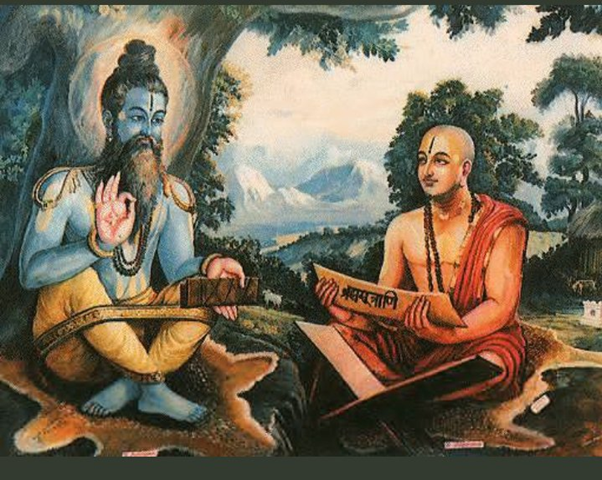
Madhvacharya at the Himalayana ashrama of Vedavyasa and Nara-Naryana
In his Mahabharata Tatparya Nirnaya, Madhva states that his intention in writing the book is to redress mistakes and misconceptions regarding the original Mahabharata text. Madhva writes:
"When the work [Mahabharata] had thus become altered in the Kali age, under the direction of Hari for its clear understanding, I shall state the settled truths having known them through His grace, and also having well known the other (extinct) works and all the Vedas through His grace, and also having examined the various editions existing in several places. Just as the all-powerful supreme Lord Vyasa who is no other than Narayana has narrated in the Bharatha and other works, I shall also, with the knowledge imparted by Him, briefly state the essential teachings of all the Sastras, in accordance with the interpretation of Bharatha." (Mahabharata Tatparya Nirnaya Adhyaya 2: 5-9)
Since Madhvacharya is none other than Bhima himself, it becomes apparent as one reads Madhvacharya's Mahabharata Tatparya Nirnaya that it is a first-hand or personal account of the extraordinary events that took place on Earth as the end of dvapara-yuga. As we shall see presently, Madhvacharya's confirmation of the conquest of the great Earth circle by the Pandavas, only 5,000 years ago, completely shatters the modern idea beleaguering modern Vedic cosmology, namely that the Earth is a small round globe floating in space with a limited circumference of 24,900 miles.
Now let us look at Madhvacharya's statements regarding the Pandavas campaign on the Earth at the end of the dvapara-yuga (around 5,000 years ago). As with Srimad Bhagavatam and Mahabharata, Madhvacharya begins his Mahabharata Tatparya Nirnaya by explaining how at that time, great demons had incarnated on the Earth causing adharma (irreligion) to flourish. As stated in Srimad Bhagavatam:
"Once when mother earth was overburdened by hundreds of thousands of military phalanxes of various conceited demons dressed like kings, she approached Lord Brahma for relief." (SB 10.1.17)
nrpa-vyaja—posing as kings, or the supreme power personified in the state; daitya—of demons
In chapter 16 of the Bhagavad-gita, Krishna describes the difference between the divine (daivam) and demoniac (asurim) nature. Krishna says that those possessed of the asuric mentality engage in terrible activities (ugra-karmanah) that lead to the destruction of the world (kshayaya jagato 'hitah).
"Following such conclusions, the demoniac, who are lost to themselves and who have no intelligence, engage in unbeneficial, horrible works meant to destroy the world." (Bg 16.9)
The presence of so many asuras on the Earth 5,000 years ago led also to the appearance of Lord Krishna along with many of His eternal associates, including the Pandava brothers (Yudhisthira, Bhima, Arjuna, Nakula, and Sahadeva). The Pandavas were Lord Krishna's instruments to remove the asuras from the Earth, and to re-establish dharma; as Krishna states in Bhagavad-gita:
"The Supreme Personality of Godhead said: Time I am, the great destroyer of the worlds, and I have come here to destroy all people. With the exception of you [the Pandavas], all the soldiers here on both sides will be slain.
Therefore get up. Prepare to fight and win glory. Conquer your enemies and enjoy a flourishing kingdom. They are already put to death by My arrangement, and you, O Savyasaci, can be but an instrument in the fight" (Bg 11.32-33)
The incarnation of Dharma was King Yudhisthira, the eldest brother of the Pandavas. However, before Yudhisthira could be installed as emperor of the world at the great Rajasuya sacrifice, it was necessary for the Pandavas to gain allegiance from all subsidiary kings on the Earth. The following is from chapter 21 of Madhvacharya's Mahabharata Tatparya Nirnaya, which describes the conquest of Bhu-mandala by the Pandavas:
"Later Lord Sri Vedavyasa arrived and instructed the Pandavas to start preparing for the yagna. He asked them to perform paramashwamedha yagna which includes rajasuya yagna which was not performed by anyone except brahma. (21.174)…
Then Arjuna spoke "Oh lord I have the best bow, flag and chariot, therefore I wish that you will entrust the task of invasion to me" (21.180)…
[Vyasa to Arjuna:] You proceed in Northern direction which is being taken care of by Kuvera, win the saptadweepas, nagaras in all the zones (east, west, etc.), all the demons and the demons who are in patalalokas and return back as soon as possible (21.188)
You have divine chariot which can move in the sky, and also divine bow and divine arrows. Inspite of this let Bhima go to defeat Bana and others who have boons from Shiva. (21.189)
Similarly, on my instructions, other noble deities will also pay tributes to Bhima. Later let Nakula and Sahadeva proceed to western and southern regions respectively for invasion and let them acquire fame and virtue.' In this manner, having been instructed by Vedavyasa, all those men of great virtues, prostrated to him with devotion and left in their respective directions." (21.190-91)
We should understand that this campaign by the Pandavas was not a war of aggression for material gain, but rather a campaign to restore the dharma on Earth that had been disturbed by the demons who had incarnated at that time. We should also carefully note how Madhvacharya narrates Vyasa's instruction to Arjuna to conquer the sapta-dvipa, as well as the daityas and nagas who dwell in patalaloka. This is clearly mentioned in the Sanskrit text to 21.188:
prayāhi ca tvaṁ dhanadaprapālitāṁ diśaṁ dvīpān sapta cāśeṣadikṣu |
nāgāṁśca daityāṁśca tathā'dharasthān vijitya śīghraṁ punarehi cātra
Dr. Vyasanakere Prabhanjanacharya in his translators note to this verse restates for clarification: "Vyasa assigned the Northern region for Arjuna. First the northern region of Bharata-khanda, then all the dwipas, daityas in all directions, nagaras and other inhabitants of patala loka (lower region of earth)." In the translator's note to 21.189, Dr. Vyasanakere Prabhanjanacharya also mentions the unique description of Arjuna's chariot that can "not only move on earth but also in the skies. This is the reason why he can not only travel to all the dwipas but also to patala and defeat the inhabitants there."
These verses from the work of a great acharya are vitally important in this cosmological discussion of the Vedic Earth because they describe the extent of the Earth that was about to be conquered by Arjuna. The sapta-dvipa (seven islands) are the main inhabited areas of the great Earth circle (note: there are other massive parts of the Earth circle such as the golden land (bhumih kancani) and aloka varsha that are not inhabited). The sapta-dvipaare consistently described in the cosmology section of all 18 Puranas; the Puranas all concur in their measurement of sapta-dvipa as an area covering hundreds of millions of miles. The description of sapta-dvipa begins with a description of the smallest island called Jambudvipa which is measured at 100,000 yojana (800,000 miles) and which is surrounded by an ocean of equal size. The other six islands surround Jambudvipa in the form of concentric circles (circle within a circle). The sapta-dvipa expand across the Earth's surface like ripples in a pond. Each island and ocean is uniquely double the size of the preceding one. Together they form part of the great Earth plane that stretches across the central part of the universe as seen in the image below:
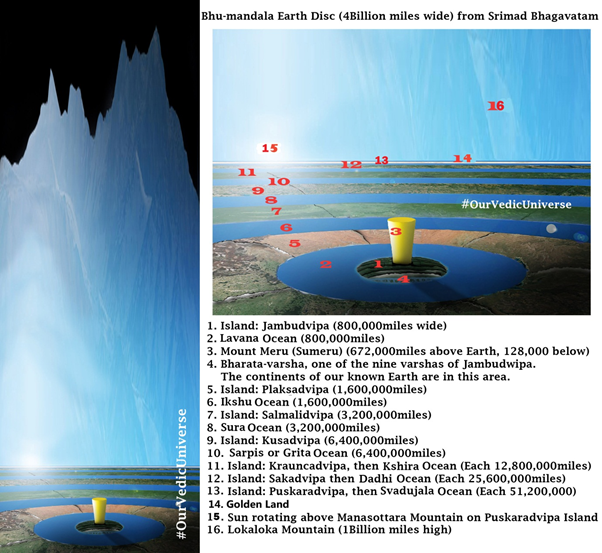
Part of the surface of the Vedic Flat Earth showing seven islands (sapta-dvipa) and surrounding oceans.
The above image shows the surface of the Vedic flat-Earth with seven islands (sapta-dvipa) and their surrounding oceans spread out in the form of concentric circles. The golden colored Mount Meru is shown here in the central island of Jambudvipa. Jambudvipa is 800,000 miles in diameter, and our own part of the Earth (Bharata-varsha) is located in the southern area of this vast area. From Bharata-varsha, Arjuna conquered all other parts of the Earth's seven islands. A brief description of the lands and various types of people on sapta-dvipa (seven islands) can be found in Srimad Bhagavatam's fifth canto, chapters 16-20 beginning with the description of Jambudvipa.
In the texts cited above from chapter 21 of Madhvacharya's Mahabharata Tatparya Nirnaya, we have heard Madhva refer to the sapta-dvipa (seven islands), patala, etc. In case anyone was to doubt Madhvacharya's understanding of the size of the Earth in question, in the same chapter he has provided measurements for the size of the Earth and its seven main islands. The measurements are, of course, (as would be expected from a Vaishnava acharya), the same as those stated in Srimad Bhagavatam. In chapter 21, verses 15-40 of the Mahabharata Tatparya Nirnaya, Madhvacharya begins a brief cosmological description by narrating the pastime of Krishna and Arjuna travelling across the islands of the Earth in order to retrieve the stolen son of a brahmana. The pastime is also told in Srimad Bhagavatam, canto 10, chapter 89, and again informs us of the extraordinary magnitude of Krishna's pastimes over the huge scope of the Earth circle:
"The Lord's chariot passed over the seven islands (sapta-dvipa) of the middle universe, each with its ocean and its seven principal mountains. Then it crossed the Lokaloka boundary and entered the vast region of total darkness." (SB 10.89.47)
Madhvacharya writes that when they returned, Arjuna asks Krishna about the various lands that they just seen. Krishna replies by first describing the size of Jambudvipa:
"This Jambu island and this ocean of salt is laksha yojanas in area. All the other islands and oceans are two times greater in area than the one before respectively." (21.41)
Laksha yojana is 100,000 yojana (800,000) miles. Krishna says here that each island doubles in size from the one before. Plaksadvipa is, therefore, 1,600,000 miles across (twice the size of Jambudvipa). In this way each island is double the size of the one before. Madhvacharya continues (verses 41-68) with a brief description of the main areas of the Earth including Patalaloka, all of which is held up by Ananta-sesha. The entire area is described as covering hundreds of millions of miles. Thus there is no doubt that Madhva's understanding of the Earth conforms in every detail to the description contained in Srimad Bhagavatam.
In the verses that will follow below (21.223 and 21.224), Madhvacharya narrates that Arjuna followed Vyasa's instructions and conquered all of the above mentioned areas on the surface of the Earth, as well as the great underground realms in Patala. Starting with sapta-dvipa, Madhva writes:
pArtho jitvA.ashhTavarshhANi shhaD.h dvIpAnaparAnapi | ajayachchaturdishamapi sarvashaH shastratejasA || 21.223||
"With his brilliance in his shastra and astras, Arjuna conquered eight varshas, other 6 other dwipas and all four directions." (21.223)
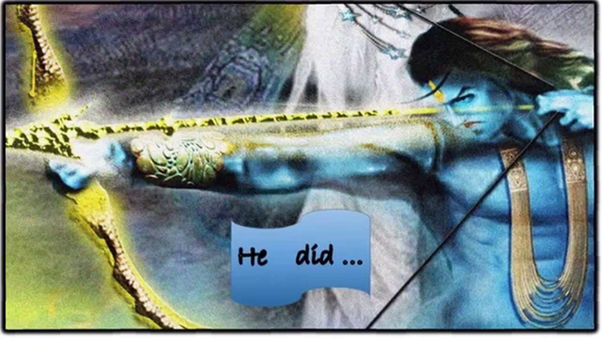
Arjuna with his divine bow named Gandiva.
Dr. Vyasanakere Prabhanjanacharya in his translators note to the verse again restates for clarification:
"Notes: (1) Other eight varshas means Kimpurusha, Harivarsha, Ilavtrita, Bhadraswa, Ketumala, Hiranmaya, Ramya and Kuru. This along with Bharata-varsha is total of 9 varsha's. (2) Remaining six dwipas means Plaksha, Shalmali, Kusha, Krauncha, Shaka and Pushkara, along with Jambudwipa forms 7 dwipas. (3) It has to be noted that Vyasa had already informed about all these earlier (verse.188). It has already been mentioned that the main reason why Arjuna was able to conquer all these was because he had the extraordinary flying chariot."
The nine varshas refers to the divisions of Jambudvipa which cover an initial 800,000 miles of the Vedic flat-Earth. One can read about these areas in Srimad Bhagavatam, canto 5, chapters 16-19. The position of Bharata-varsha on the flat-Earth plane is correctly depicted in the image below showing Bharata-varsha at the southern side of the circular shaped island of Jambudvipa with the great Mount Meru situated in the center. Bharata-varsha, incidentally, is located a few hundred thousand miles south of Mount Meru. Meru itself is 800,000 miles high, and thus, neither the North Pole or the Pamir Mountains as people like to speculate.
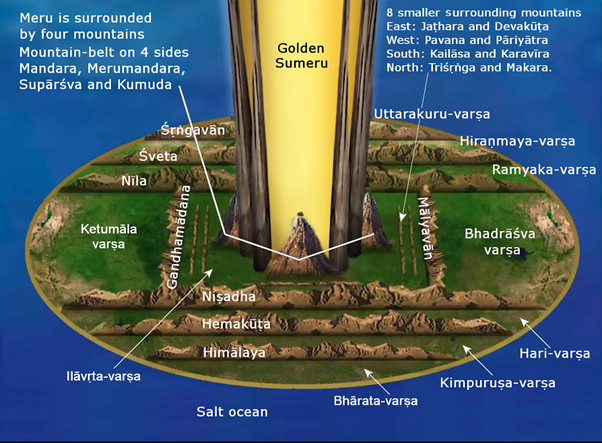
The nine varshas of Jambudvipa, the central island on the Vedic flat-Earth. Our known Earth is in the area of Bharata-varsha
The Mahabharata also confirms that the 'hundreds of millions' of soldiers who partook in the Kuruksetra war also came from all over Jambudvipa:
"The whole earth seemed then to be empty, divested of horses and men, destitute of cars and elephants, and with only the children and the old left (at home). From the whole area of Jambudwipa over which the sun sheds his rays, was collected that force, O best of kings. Men of all races, assembled together, occupied an area extending for many Yojanas over districts, rivers, hills, and woods…
… Indeed, that encounter of the two armies was highly wonderful, like that of two oceans when the end of the Yuga is arrived. The whole earth was empty, having only the children and the old left (at home), in consequence of that large army mustered by the Kauravas." (Mahabharata, Bhishma-parva, Jambu-kanda, Section 1)
A full description of the Bhu-mandala in Mahabharata can be found in the Bhishma Parva beginning at section 4. In this section, although Jambudvipa is called by the name Sudarshan ('circular and round like a wheel'), the description for the most part follows the other Puranas.
The Kurukshetra battle was a later war from this initial conquest of Bhu-mandala by Arjuna and the other Pandavas. However, it was the wealth and prestige gained from this campaign that led the envious Duryodana to conspire and cheat the Pandavas of their kingdom—an event that acted as the catalyst for the major battle at Kuruksetra.
From Jambudvipa, Arjuna had proceeded to conquer the other six islands which surround Jambudvipa in a circular formation, and which cover an area of over 200 million miles. The description of these other islands can be found in Srimad Bhagavatam, canto 5, chapter 20.
In the Mahabharata Tatparya Nirnaya Madhvacharya recounts the varied conquests of Arjuna, Bhima, Nakula, and Sahadeva across the entire plane of Bhu-mandala with each brother taking a different direction. The following verse spoken by Draupadi in Mahabharata itself also confirms Yudhisthira's control of the different varshas of Jambudvipa along with the other islands of Bhu-mandala:
"Formerly, O puissant one, thou hadst, O monarch, swayed with might, the region called Jambu-dwipa, O tiger among men, abounding with populous districts. Thou hadst also, O ruler of men, swayed with might that other region called Kraunchadwipa situated on the west of the great Meru and equal unto Jambu-dwipa itself. Thou hadst swayed with might, O king, that other region called Sakadwipa on the east of the great Meru and equal to Krauncha-dwipa itself. The region called Bhadraswa, on the north of the great Meru and equal to Sakadwipa was also swayed by thee, O tiger, among men! Thou hadst even penetrated the ocean and swayed with might other regions, too, O hero, and the very islands begirt by the sea and containing many populous provinces. Having, O Bharata, achieved such immeasurable feats, and having obtained (through them) the adorations of the Brahmanas, how is it that thy soul is not gratified?" (Mahabharata, Shanti-parva, XIV)
The scale of this operation is beyond the conception of the mundane mind that simply dismisses it as Hindu mythology. However, the only reason why we are no longer in contact with other parts of the Earth circle, nor under the governance of such exalted spiritual kings as Yudhisthira, is due to the on-set of Kali-yuga that affects Bharata-varsha but not the rest of Jambudvipa. The Srimad Bhagavatam describes that the other eight varshas of Jambudvipa enjoy the conditions of treta-yuga and are thus not affected by Kali-yuga (5.17.12). This is confirmed in many Puranas; for example, in the Linga Purana, Bharata-varsha is distinguished from the other eight varshas of Jambudvipa because they do not experience the succession of yugas:
"There is natural perfection in all the eight excellent subcontinents beginning with Kimpurusha. Without any strain the subjects are always happy. The opposite of joy is not seen in them. They have no fear from death or old age. They have neither dharma or adharma. There is no distinction such as the excellent, the middling, and the base. In all these eight sub-continents there are no subdivisions of yugas." (Linga Purana, Chapter 47: 13-15; translation by JL Shastri, 1951, Delhi)
The Linga Purana goes on to explain that duties for the four yugas only occur in Bharata-varsha:
"It is only here [bharata-varsha] that human beings endeavour for heavenly pleasures and salvation. O leading sages, only here they pursue the duties specified for each yuga, not elsewhere." (Ibid, Chapter 52, verse 32)
In the Vishnu Purana it is also stated:
"...In the Bharata-varsha it is that the succession of four Yugas, or ages, the Krita, the Treta, the Dwápara, and Kali, takes place." (Vishnu Purana, Book 2, Chapter 3, translated by Horace Hayman Wilson, 1840)
Due to the arrival of Kali-yuga, Bharata-varsha becomes isolated from the other parts of Bhu-mandala and the age of chaos is allowed to run its course without disturbing the other parts of the Earth. Ignorance of the greater Earth is just one aspect of the all-pervading ignorance that follows as people in Bharata-varsha become more materialistic and their spiritual knowledge is lost. The Vedic kings remove their benign influence and the people are governed instead by blood drinking rakshashas who pose as leaders of the people:
prajas te bhakshayisyyanti mleccha rajanya-rupinah (SB 12.1.39-40)
"These barbarians in the guise of kings will devour the citizenry"
For the benefit of all those still retaining faith in the spiritual reality, Srimad Bhagavatam manifests to provide information of the satyam param or Absolute Truth:
"This Bhagavata Purana is as brilliant as the sun, and it has arisen just after the departure of Lord Krishna to His own abode, accompanied by religion, knowledge, etc. Persons who have lost their vision due to the dense darkness of ignorance in the age of Kali shall get light from this Purana." (SB 1.3.43)
Knowledge of these various places both in the material and spiritual world is provided in the various Puranas so that the living entities can make informed choices about their future destinations. We are presently restricted from entering the different areas of Bhu-mandala due to the superior controlling power of devas who keep living entities in their apportioned parts of the Earth circle. One is placed in a particular area according to karma, and in ordinary circumstances one cannot enter another area by mechanical means such as a flying craft or rocket of some-sort. The idea of travelling to other places by means of a vimana (flying craft) is not entirely out of the question since the Puranas are full of stories of individuals or groups who fly from place to place on vimanas, or who otherwise travel by yoga power. Although descriptions of these modes of travel are more common-place than exceptional in Vedic literature, they do tend to come from a time when people were more advanced in spiritual science. As mentioned above, due to the advent of Kali-yuga the vast majority of the population have no qualification to travel freely in this way. In any case, the general procedure for entering either higher or lower regions of the universe depends on the performance of yajna, charity, etc., performed during a number of lifetimes in Bharata-varsha. Bharata-varsha is where karma is created and the soul suffers or enjoys the fruits of karma in the next life. Upon death, the soul reincarnates into respective locations according to actions performed in the present and past lives lived out in Bharata-varsha.
From Vedic history (purana) we learn that not only did Arjuna conquer all of the seven islands on the surface of the Earth circle, but that he also conquered the regions within the core of the great Earth circle wherein live the great daityas and nagas. Daityas are powerful demons with human-like form, whilst nagas are beings with dual human/serpentine characteristics.
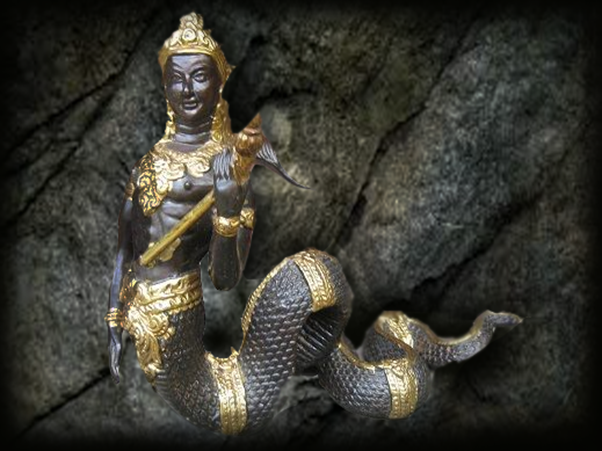
The nagas are described as having dual human and serpentine characteristics. Depictions of the nagas are varied.
These places within the Earth where the daityas and nagas live are referred to alternatively as bila-svarga or Patalaloka. In the text below Madhva has referred to them by the name Patala. Although the name Patala is the specific name of only one of the seven realms within the Earth, the name generally doubles in Vedic literature as a term to describe all seven realms together. They are sometimes also collectively known as Rasatala, although that again is the specific name of only one of the seven realms. These seven underground worlds are not hells (which are at a separate location, though also within the Earth itself). Madhva continues by specifically mentioning the name Patala:
pAtALasaptakaM gatvA jitvA daiteyadAnavAn.h | baleshcha vishhNuvachanAt.h karaM jagrAha sAmataH || 21.224|| 21.224.
"Arjuna went to the 7 worlds below the earth [Patala] and conquered all the demons (daityas and danavas). As per Vishnu's instructions, he accepted the tributes paid by Bali using peaceful route." (21.224)
The following commentary is by Dr. Vyasanakere Prabhanjanacharya in his translators note to this verse:
"Notes: (1) Among the important kings in the nether worlds, Bali the king of Sutala world was the most important. He was graced by Shri Hari as future Indra. Grandson of Prahlada. He offered tribute to Arjuna through peace as per instructions of Shri Hari. Arjuna accepted it and proceeded. (2) It has to be noted that by showing that it is appropriate to follow peaceful route with Bali who was a follower of Vishnu, he indicated the fact that it is not acceptable to have enmity with Vaishnavas. Here form of Hari means both Vamana form and Kapila form."
Bali's underground kingdom is described in SB 5.24.18. A full description of these seven extraordinary underground worlds that were conquered by Arjuna can be found in Srimad Bhagavatam, canto five, chapter 24. Madhvacharya continues:
"After defeating Vasuki as well and accepting lots of precious gems from him, brave Arjuna hurriedly returned to his kingdom within a year." (21.225)
Vasuki is a great serpentine being and his city within the Earth is described in Srimad Bhagavatam:
"Beneath Rasatala is another planetary system, known as Patala or Nagaloka, where there are many demoniac serpents, the masters of Nagaloka, such as Sankha, Kulika, Mahasankha, Sveta, Dhananjaya, Dhritarashtra, Sankhacuda, Kambala, Asvatara and Devadatta. The chief among them is Vasuki. They are all extremely angry, and they have many, many hoods—some snakes five hoods, some seven, some ten, others a hundred and others a thousand. These hoods are bedecked with valuable gems, and the light emanating from the gems illuminates the entire planetary system of bila-svarga." (SB 5.24.31)
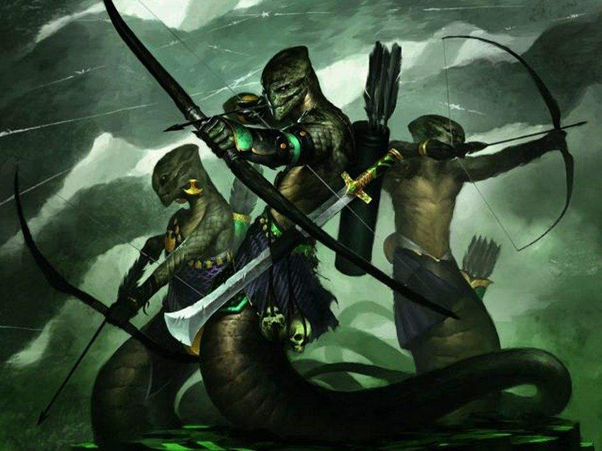
Artists depiction of Naga warriors
So where are these nether regions that were conquered by Arjuna, what is their size, and what does their description tell us about the nature of the Vedic Earth? In his translation to the above verse from Srimad Bhagavatam, Srila Prabhupada refers to Rasatala and Patala as 'planetary systems' (SB 5.24.31). Since Srila Prabhupada himself spoke of the Earth as a globe, and referred to the bila-svarga as "the lower planetary systems," this may create the impression in one's mind that the bila-svarga or Patala are seven layers of globe-like planets floating beneath a globe-shaped Earth planet as is often presented in ISKCON imagery, such as the picture below:
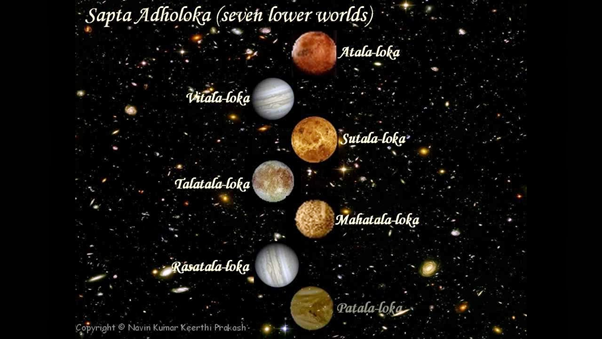
The seven subterranean heavens (bila-svaraga) worlds are not planets as depicted above.
Although Srila Prabhupada's language is certainly suggestive of the idea that Patala and Rasatala are a series of globe-like planets floating in space, the actual description in Srimad Bhagavatam presents them as just underground realms belonging to the Bhu-mandala itself.
As we shall see from the relevant texts that follow, there is no doubt that Patala is just the underground part of the great circle itself, and not a series of separate planets as may be inferred from Srila Prabhupada's use of the word 'planets' to describe them. We must bear in mind that the English word 'planet' was simply Srila Prabhupada's default term for the Sanskrit word loka, which means a living place, region, or people, not a planet as we commonly understand them. One has to understand Srila Prabhupada's language in the context of the description of the Earth as it is given by Sukadeva Goswami, otherwise one will come to a completely erroneous belief based on one's own assumption of what 'a planet' refers to. We have discussed the question in a previous paper entitled, "Why Did Srila Prabhupada Call the Earth a Globe? " The paper can be found here.
Without understanding the context in which Srila Prabhupada's used the English word 'planet' to describe different locations such as Jambudvipa or Patala—locations that are clearly either on or within the Earth circle (Bhu-mandala)—one ends up creating an entirely different conception of the universe from that described in Srimad Bhagavatam. Instead of understanding the Bhu-mandala as a huge circular disc with vast underground realms containing the bila-svarga (subterranean heavens) and naraka (hells), one will instead think of the Earth as a small globe with other globe-like planets floating beneath it. This is an entirely wrong conception of the Vedic Earth as we shall presently see. To understand the difference in concepts, we have to assiduously follow Srila Prabhupada's own instruction regarding the depiction of the Earth and other features of the universe:
"We must exactly follow the description of Bhagavatam. As we are going to spend many crores of rupees, and there will be those who will try to find fault in our presentation, 'Caesar's wife must be above suspicion.' I have explained whatever I could already in my books. Now my brain is no longer able to work properly. You young men can tax your brains to understand the Sanskrit and English descriptions and present them." (TKG's Diary: Prabhupada's Final Days, May 30 1977)
"Now our Ph.D.'s must collaborate and study the Fifth Canto to make a model for building the Vedic Planetarium... So now all you Ph.D.'s must carefully study the details of the Fifth Canto and make a working model of the universe. If we can explain the passing seasons, eclipses, phases of the moon, passing of day and night, etc., then it will be very powerful propaganda." (Letter from Srila Prabhupada to Svarupa Damodara dasa, April 27, 1976)
Srila Prabhupada delegated the responsibility for researching and presenting Vedic cosmology to his disciples because he did not consider himself as expert in that particular area. In our previous papers we have cited many statements from Srila Prabhupada in this regard and won't repeat them here.
In the image below that follows closely the description of Srimad Bhagavatam, we can see a section of the Bhu-mandala with seven islands on the surface as well as the seven underground levels within its core:
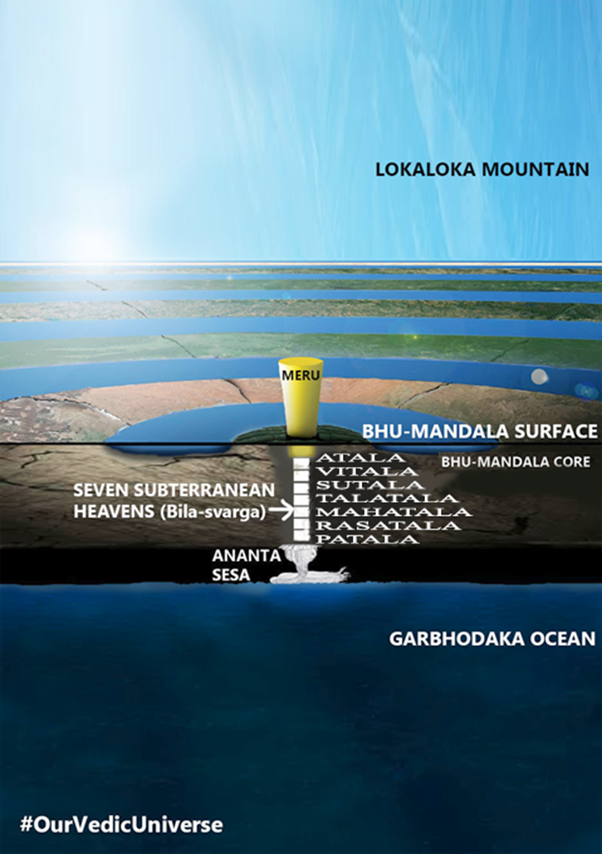
The seven realms (bila-svarga) within the core of the Earth circle
Sesha-naga who resides on the Garbhodaka ocean, holds the entire Bhu-mandala from below. All of the above is described by Sukadeva Goswami in response to King Pariksit's inquiry about the 'names', 'measurement', 'characteristics', and 'form' of the Bhu-mandala (See SB 5.16.1-4). By following Sukadeva Goswami's reply to King Pariksit we can understand that the seven realms of Bila-svarga, namely Atala, Vitala, Sutala, Talatala, Mahatala, Rasatala and Patala, are located as underground realms within the core of the great Bhu-mandala itself, not as globe-shaped planets floating in space. We have discussed the issue in a paper called, "What's Below the Earth? " The paper can be found here.
Although Srila Prabhupada spoke of 'lower planetary systems' and 'hellish planetary systems', neither the subterranean heavens (bila-svarga) nor the hells (naraka) are a series of globes floating in space; rather, the bila-svarga and the narakas are a series of underground realms within the core of Bhu-mandala itself. Other than Ananta-sesha who holds Bhu-mandala from below, there is no description of any planets or stars below the Bhu-mandala. Likewise, what Srila Prabhupada called 'the earthly planetary systems' are actually the seven great islands on the surface of the Bhu-mandala where all the humans and other creatures live. The 'heavenly planets', again, are simply the demigod cities on top of Mount Meru (svarga) which is located in Ilavrta-varsha, one of the eight varshas belonging to Jambudvipa that are regarded as bhumi-svarga (heavens on earth).
In order to appreciate the above assessment, the reader must bear in mind that most of the description of the universe in Srimad Bhagavatam's cosmology section, actually focuses on the Earth (Bhu-mandala). This is not because the rest of the universe was unknown to the Vedic seers, but because Bhu-mandala is where most of the living beings in the Vedic universe reside—either on the surface upon the seven great islands, or below the surface in the seven great subterranean realms (Patala), or within the numerous hells which are located below Patala. Even Svarga where the devas live, is technically still part of the Earth being located on top of Mount Meru; and even those living beings situated as luminaries (stars, etc.), or the sages on Maharloka, Janaloka, Tapaloka, etc., can only achieve that situation as a result of sacrifices performed on Earth, specifically in Bharata-varsha where all karma deciding one's future destiny is created.
The modern idea of stars and planets that are millions of light years away in an unending universe is simply hyper-speculation on the part of NASA employees who are paid to create a false construct of reality and confuse everyone about the nature of reality. The Vedas do describe a multi-universe, but each universe is actually of limited expanse being enclosed within a round-shaped shell (brahmanda). Our particular universe is small by comparison being 4 billion miles across the center, and four billion miles from top to bottom. The bottom half (or bottom 2 billion miles) of this round-shaped universe is filled with water (Garbhodaka Ocean). Resting on this water is Ananta-sesha who holds the Bhu-mandala some 240,000 miles above the surface of the Garbhodaka Ocean (this is the distance between the Garbhodaka ocean and the bottom of the Earth; see SB 5.25.1).
The Bhu-mandala being the largest feature in the universe, stretches across the center of the universe and all the stars and nine planets are above its surface area. Unlike the modern images that show the Earth floating in space and surrounded by the sun and moon and other stars in all directions, the Srimad Bhagavatam states that all the luminaries are hundreds of thousands of miles above the Earth circle, and that there is nothing below the Earth circle except darkness and the self-illumination of Ananta-sesha who resides on the Garbhodaka ocean and holds the Earth from below.
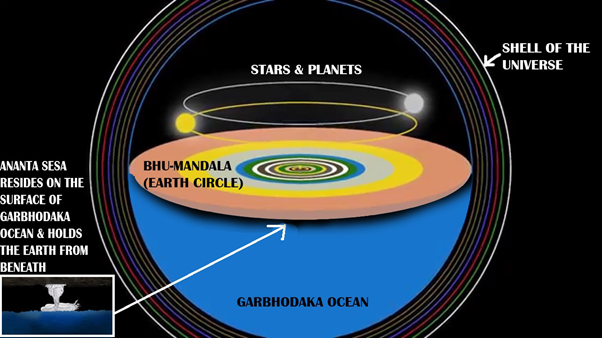
The Bhu-mandala crosses the center of the universe
The Earth disc covers the entire span of the center of the universe and thereby divides the universe into three modes of nature. Thus due to the great Earth circle spanning the center of the universe and creating a division of the modes of nature, there is no sunlight, nor stars, or planets below the surface level of Bhu-mandala. As stated in Brahma-vivarta Purana:
"This world [Goloka] is beyond the material world. There is no world higher than this. Above this (Goloka) there is nothing. What exists culminates in this world. In the same way, there is nothing below the seven realms of Rasatala. Below them is only impassable and invisible water and darkness." (BrahmaVivarta Purana 4.4.189-91)
Here the name Rasatala is used interchangeably with Patala to describe the seven underground realms within the core of the Bhu-mandala. Ananta-sesha holds the entire weight of Bhu-mandala from below and resides on the surface of the Garbhodaka ocean, ('the impassable water', mentioned in the above verse). As we can see in the image of Ananta-sesha below, excluding Ananta-Sesha and Vishnu who are self-luminous, there is nothing but darkness between Sesha and the bottom part of the Earth circle. The seven realms of Patala (bila-svarga) are thus above Sesha and within the Earth's core.
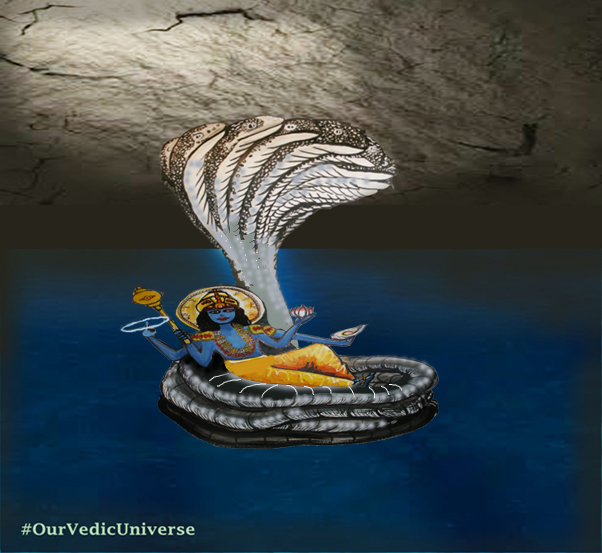
Ananta-sesha holding the Earth from below
Ananta-sesha forms the bed of Vishnu as described in Srimad Bhagavatam:
All the planets of the materialistic persons, including all the heavenly planets, such as the moon, are vanquished when the Supreme Personality of Godhead, Hari, goes to His bed of serpents, which is known as Ananta Sesha. ( (SB 3.32.4)
sayyayam—on the bed; sete—lies; ananta-asanah—He whose seat is Ananta Sesha; harih—Lord Hari
The description of Ananta-sesha holding the Bhu-mandala is confirmed in Srimad Bhagavatam and the relevant verses can be found in the following paper: "Does the Earth Float in Space?" The paper can be found here.
The description of Ananta-sesha holding the Earth is confirmed in all the other Puranas, but Skanda Purana provides a perfect analogy comparing Ananta-sesha to a pedestal upon which rests the Earth herself:
Sri Varaha said:
34. 0 Goddess Earth, I established you on the delightfully pleasing head of Sesha. I placed the world (people) on you with the mountains as your assistants. Thereafter I came here, 0 gentle lady...
Earth replied:
35-36. You lifted me up from the nether worlds and made me stable and steady on the (head) of Ananta splendid with a thousand hoods, as if on a high pedestal studded with jewels and precious stones. (Skanda Purana II.i. I. 34-36)
In the above dialogue between Bhu-devi (the personified Earth) and Varaha-deva, it is stated how Ananta-Sesha acts like a pedestal to hold the Earth circle; one could think, for example, of a round table that is held by a single stand.

Just as the circular table is held by a single stand and a base, so the Earth circle is supported by Ananta-sesha whose base is the Garbhodaka ocean upon which Sesha floats. Some Puranas also include the Kurma avatara as the base of Sesha who likewise floats on the Garbhodaka ocean, but that specific detail is not given in Srimad Bhagavatam itself. We do not discount the idea, but simply wish to point out that it is not mentioned in Srimad Bhagavatam. In the above analogy, we have compared the round part of the table to Bhu-mandala, and the stand to Ananta-sesha; and just as a circular table has a depth of a few inches, so the Earth circle has a depth of hundreds of thousands of miles. The Patala and hells are located within the depths of the Earth circle itself.
The Earth is nowhere described in the Vedic texts as a round globe floating in space. Although the Vedic Puranas do state that nine planets and other stars float and rotate in space (though not by the power of gravity, but by the power of vayu—wind), the great Earth disc is an exception to this rule in that it is held by Ananta-sesha. The Earth neither floats nor moves in space as do the other nine planets. Indeed the Bhu-mandala (Earth circle) is not even counted as a planet (graha) in Vedic cosmology. The Bhu-mandala is in its own unique category being the largest feature in the universe and the support of all other beings. See the above link to the paper entitled: "Does the Earth Float in Space" The reader may also refer to this paper in regards to the nature of the Earth that was raised by the Varaha avatara.
It is a difficult task to unravel the numerous misconceptions, mis-translations, interpolations, lack of knowledge, and general lack of faith in the texts describing the Vedic Earth, what to speak of the more devious deception and cheating that has taken place by those who are entirely envious and destructive of the Vedic world-view. Beginning with the English Imperialists, this process of speculation and misinformation has been going on over the last few centuries. Due to the prevailing idea that the Puranas are India-centric in their historical scope, as well as the general inculcation of Western propaganda that the Earth is a globe of limited size, those responsible for the original Western translations and commentaries of the Puranas invariably took it for granted that all place names mentioned as being on the Bhu-mandala must be references to places in and around India. Despite reading descriptions of the Earth's main islands that run into hundreds of millions of miles, the speculators simply dismissed such descriptions as imaginary and applied their own deluded ideas as to where these places may be situated within and around India itself. In this way, knowledge and faith in Bhu-mandala practically disappeared over-night.
Unfortunately, the later generations of Indians and others pertaining to expound 'Vedic cosmology' have followed the understanding of the English Imperialists, and in this way knowledge of the greater Earth has become covered over with speculation upon speculation. The same inculcation of Western propaganda regarding the Earth globe affects members of ISKCON as can be seen in the image below produced for Vediccosmolgy.com which shows the circular island of Jambudvipa with Mount Meru in the center, but with a rather incongruous Earth globe representing the varsha of Bharata-kanda:
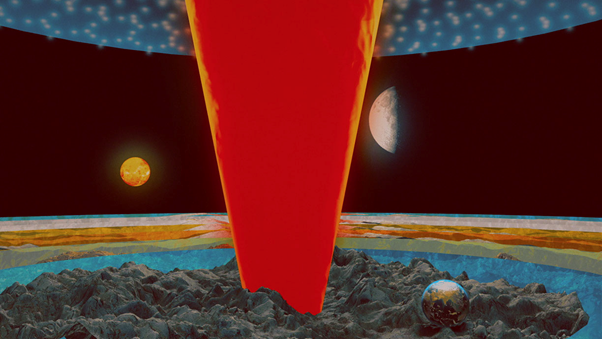
The Vedic Earth wrongly depicted as a merge between an Earth-globe and an Earth-circle
The idea suggested in the above image is that the although the Earth is part of Bhu-mandala, it nonetheless manifests to our vision as a globe in space, and we simply can't see the rest of Bhu-mandala because it is in another dimension. But why even place a globe (representing Bharata-varsha) on the plane of Bhu-mandala? Bharata-varsha is part of the same plane as the rest of the Earth circle. It is not a globe. The concept is simply another attempt to incorporate the designers own personal inculcation of the Earth globe concept/belief with the original Bhu-mandala (Earth circle idea).
The Vedic Earth is not some small insignificant planet floating in an empty, aimless, godless, infinite space as presented by modern astronomers and so-called scientists; nor is the Vedic Earth a globe-shaped planet that is incongruously and suspiciously suspended between space and the so-called other-dimensional reality of Bhu-mandala (as has thus far been presented by members of ISKCON). Our part of the Earth is not a ball floating in space, nor is Bhu-mandala in another dimension. Our part of the Earth is simply a small part of the bigger Bhu-mandala landscape which is very much in the same three dimensional reality as the rest of the universe.
The Earth is actually the biggest feature in the Vedic universe (spanning the entire center of the universe) and is the support of all other living beings. The Vedic Earth is, thus, very much the center of the universe. The stature and vast extent of the Earth is implicit in the following statement:
"O master of the demigods, please attempt to lift the earth, which is merged in the great water, because it is the dwelling place for all the living entities." (Srimad Bhagavatam 3.13.15)
okaha—the dwelling place; sarva—for all; bhutanam—living entities; mahi—the earth
The Earth is called mahi here because of her greatness (which includes her great size). A similar description of the Earth is given in SB 3.13.30:
"Lord Boar penetrated the water with His hooves, which were like sharp arrows, and found the limits of the ocean, although it was unlimited. He saw the earth, the resting place for all living beings, lying as it was in the beginning of creation, and He personally lifted it." (SB 3.13.30)
gam—the earth; yam—whom; jiva-dhanim—the resting place for all living entities
Since the colossal Earth circle is the support of all living beings, this explains her primary significance in the universal affairs, and also explains why all attempts to control the universe by the asuras begin with an attack on the Earth itself; In Mahabharata we hear Sanjaya explaining the importance of the Earth to Dhritarastra:
"Everything springeth from the Earth and everything, when destroyed, mergeth into the Earth. The Earth is the stay and refuge of all creatures, and the Earth is eternal. He that hath the Earth, hath the entire universe with its mobile and immobile population. It is for this that longing for (the possession of the) Earth, kings slay one another.'" (Bhishma Parva, section four)
We must remember that the administrative seat of the devas who control universal affairs is situated on top of Mount Meru which is in the center of Jambudvipa; and Jambudvipa, of course, is the central island of the Bhu-mandala. Although svarga (regions on top of Mount Meru) are celestial by our standards here, Mount Meru is still included as part of the Earth plane. This, again, explains why Lord Krishna comes specifically to the Earth in His various incarnations in order to protect the devas, destroy demons, and restore dharma. The asuras who periodically vie for control of the Earth are normally constrained in the underground realms of Bhu-mandala, but when circumstances are favourable they rise to the surface and contend with the devas for control of the universe.
We can better understand the location of Patala from the simple fact that the Puranas are replete with histories of heroes going through caves, openings, and tunnels found on the surface of the Earth which lead them to the underground worlds of Patala. The Skanda Purana tells the history of Krishna Himself blocking the entrance to one of these gateways through which the asuras were emerging to terrorize the people on the surface of the Earth; the Bilvesha mentioned here is part of the tirtha described at Jagannatha Puri (Orissa):
"Hence-forth, I shall narrate the greatness of Bilvesha, O Brahmanas. Formerly Daityas who were residents of Patala pierced through the surface of the Earth and began to harass Bhurloka. They used to devour people. When the Lord incarnated as the son of Devaki in order to reduce the burden on the Earth, and protected the Earth along with the Yadavas and the Pandavas, He once came to that spot.
He took His bath in the water of Tirtharaja (the ocean), and paid obeisance to Nila Madhava from a great distance mentally. Then He came to the entrance (of the abode of) Daityas. He found that the underground passage was awful and impenetrable for human beings…and desirous of spreading (the idea of) the venerability of Shiva, He took up the fruit of a Bilva tree and invoked the three-eyed Lord there. After worshipping the Destroyer of the Puras, Sri Krishna eulogized him. After eulogizing His own Atman by means of His own Atman, the Lord saw the passage had become easily penetrable by His favour. Through that passage the Lord went to Patala along with His army. There He slew the Daityas who were fierce and powerful and He removed the burden (of the Earth).
He then came back to the same place. There the Lord worshipped the Bull-emblemed Lord. Desirous of establishing Shiva there in order to block the passage, the highly intelligent Gadadhara (Krishna), the Lord who can be won over by devotion, said thus: "O Dhurjati (Shiva), stay here in the place preventing asuras from coming out. Who else, O Shambhu, is competent to destroy the army of Rakshasas?" After establishing Mahadeva, He returned to Dvaraka. Since then Bilvesha became famous on the Earth." (Skanda Purana II,ii, 13.17-33)
The sons of Sagara are another famous example for having dug into the Earth as far as Patala in search of a stolen challenge horse:
"The sons of Sumati, who were very proud of their prowess and influence, following the order of their father, searched for the lost horse. While doing so, they dug (nyakhanan) into the earth (mahim) very extensively." (SB 9.9.8)
Again:
"When the sons of Maharaja Sagara were searching all over the world for their lost horse, they dug up (nikanadbhir) the earth (mahim)" (SB 5.19.29-30)
Srimad Bhagavatam does not go into much detail about the extent of the dig, but in other Puranas it is stated that they dug down as far as Patala. In Narada Purana it is stated:
"In order to find out the horse taken away by Indra with his physical body invisible, the sons of Sagara were extremely surprised and they wandered over the earth and other worlds in search of it. When they could not trace the horse, they attempted to make their way to the Patala, the nether-world. And each one of them severally dug up the earth's surface to a depth of a Yojana (eight miles). The earth dug out by them, they scattered on the shores of the ocean. All the sons of Sagara reached Patala through that passage." (Np 8.91.94-93).
Since there were 60,000 sons of Sagara, and each son tunneled for 1 yojana (8 miles), they were collectively able to tunnel for 480,000 miles. In Valmiki's Ramayana it is likewise stated that the sons of Sagara dug down as far as Rasatala. In the Ramayana it is said that for digging, the sons of Sagara were able to utilize some type of mystic power (siddhi) whereby their touch was like the vajra weapon (vajra sparsha samaih). The sons of Sagara had wizard-like skills, and with their hands alone they could blast their way down to Patala. We will present this history in another paper as it confirms the great depths of the Earth which go down for hundreds of thousands of miles. The debris from the huge excavations was so large that it created islands eight islands around the coast of Jambudvipa (SB 5.19.29-30). Clearly, from the above narrations of people entering or digging into the Earth and ending up in Patala, we can understand that Atala, Vitala, Sutala, Talatala, Mahatala, Rasatala, and Patala are located in the underground of the Earth itself, not that they are a series of globe-like planets floating in space as Srila Prabhupada's term 'lower planetary systems' might suggest to an uninformed reader. Scattered through-out the Puranas, there are literally hundreds of similar descriptions of Patala's location as being within the core of Bhu-mandala. Thus although Srila Prabhupada refers to the seven underground worlds as 'planetary systems', they should be understood as unfathomably deep caverns within the Earth itself. The bila-svarga are described as follows in Srimad Bhagavatam:
"In these seven planetary systems, which are also known as the subterranean heavens [bila-svarga], there are very beautiful houses, gardens and places of sense enjoyment, which are even more opulent than those in the higher planets because the demons have a very high standard of sensual pleasure, wealth and influence. Most of the residents of these planets, who are known as Daityas, Danavas and Nagas, live as householders. Their wives, children, friends, and society are all fully engaged in illusory, material happiness. The sense enjoyment of the demigods is sometimes disturbed, but the residents of these planets enjoy life without disturbances. Thus they are understood to be very attached to illusory happiness." (SB 5.24.8)
The great and extraordinary civilizations of each of these seven underground realms are described in some detail in Srimad Bhagavatam, fifth canto, chapter 24. The modern materialistic paradigm does not account for any great civilizations within the Earth, what to speak of civilizations that go down into an Earth which is hundreds of thousands of miles deep.
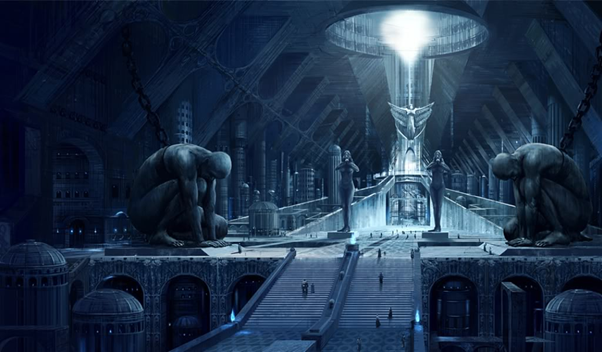
Contemporary artist's impression of an underground city
The great underground cities are described as follows:
"My dear King, in the imitation heavens known as bila-svarga there is a great demon named Maya Danava, who is an expert artist and architect. He has constructed many brilliantly decorated cities. There are many wonderful houses, walls, gates, assembly houses, temples, yards and temple compounds, as well as many hotels serving as residential quarters for foreigners. The houses for the leaders of these planets are constructed with the most valuable jewels, and they are always crowded with living entities known as Nagas and Asuras, as well as many pigeons, parrots and similar birds. All in all, these imitation heavenly cities are most beautifully situated and attractively decorated." (SB 5.24.9)
Due to the modern education and conditioning we are used to thinking of the Earth as a globe with a North and South Pole. In this estimation, the distance to the center of the Earth from any point on the surface is a mere 3,958 miles. By contrast, the Vedic description of the Earth describes Earth as great circular disc with a diameter of 4 billion miles and a depth of hundreds of thousands of miles. In Vishnu Purana, the depth of these seven realms is calculated as follows:
"Parashara: The extent of the surface of the Earth has been thus described to you, Maitreya. Its depth below the surface is said to be seventy thousand yojanas (560,000 miles); each of the seven regions of Patala extending downwards ten thousand yojanas (80,000 miles)." (Vishnu Purana Book 2, chapter 5)
The above figure of 560,000 miles is confirmed in Srimad Bhagavatam. Likewise, in Skanda Purana, Narada Muni says:
"Thus the worlds (above the Earth have been recounted to you. Listen to the nether worlds from me. All the Patala worlds together come to a height of seventy thousand yojanas (560,000 miles). They are Atala, Vitala, Nitala, Rasatala, Talatala, Sutala, and the seventh one, Patala. There are thousands of Danavas, Daityas, and serpents. Many things more beautiful than those in the heavenly world have been seen by me. The serpents there have many jewels of various kinds which cause delight (to persons). It is full of young maidens of Daityas and Danavas. They are endowed with great beauty. Who will not find Patala highly pleasant." (Skanda Purana, Book 1 (Mahesvara-kanda), Section 2 Kumari-khanda, chapter 39 verses 1-7)
The deepest bore hole drilled in modern times is the Kola Superdeep Borehole which goes down about 12 miles. The Soviet geologists were incapable of penetrating any further. Modern co-called scientific ideas about the Earth's core are, therefore, based entirely on speculation, and not on an empirical data. The Puranas describe a very different picture of what is below the Earth.
Despite some small differences between Mahabharata and the Puranas regarding details of the Bhu-mandala, it is quite clear that all these historical texts speak unanimously and consistently of a greater Earth plane with the colossal Mount Meru situated in the center, along with an unfathomable underground realm that goes down for hundreds of thousands of miles. If the Vedic history and cosmology is to be accepted as factual, then it appears that during the course of the last five thousand years of kali-yuga we have lost knowledge of these other areas of the Earth described in these ancient Vedic texts. However, despite the loss of knowledge of Bhu-mandala, sightings and encounters with so-called 'alien' races appear to be on-going. The so-called 'aliens', however, are not coming from other 'planets'; rather, the more benign beings would be coming from svarga or other other parts of the Earth's surface where people (for the most part) are described as living in peace. The 'aliens' with a more sinister or malevolent purpose would be coming from within the core of the Earth itself.
Despite NASA's images of an Earth globe floating in space and surrounded by planets and stars in all directions, the Vedic Earth disc is described as covering the entire span of the center of the universe and thereby dividing the universe into three modes of nature. The planets and luminaries are in the mode of goodness (sattva) and belong to the upper regions of the universe. The idea that evil 'aliens' are visiting from other planets is another great fiction because—with the exception of Rahu and Ketu—all of the beings in the universe above the Earth plane who reside as stars and planets or as sages in Maharloka etc., are of the nature of sattva (goodness). What we speak of as 'aliens' are actually coming from other parts of the Earth circle or from the deep realms within the underground parts of the Earth circle. According to their respective mode of nature, they will exhibit either benign or malign behaviour. The mixed modes of goodness (sattva), passion (rajas), and ignorance (tamas) appear on the surface of the Earth itself, whilst those with predominately tamasic disposition are located within the underground realms of the Earth. The great daityas and danavas (those possessed of asuric disposition) are predominately of the modes of passion (rajas) and tamas (darkness), and live within the depths of the Earth. The daityas are described as having great materialistic civilizations in these underground worlds, and are equipped with all forms of scientific technology and magical powers (maya). In Srimad Bhagavatam, Sukadeva Goswami states:
"My dear King, now I shall describe to you the lower planetary systems, one by one, beginning from Atala. In Atala there is a demon, the son of Maya Danava named Bala, who created ninety-six kinds of mystic power. Some so-called yogis and svamis take advantage of this mystic power to cheat people even today." (SB 5.24.16)
The Puranas are full of histories of the wars between devas (demigods) and asuras (demons). The Skanda Purana, for example, narrates the gripping history of Taraka who led an army of hundreds of millions of asuras (demons) travelling in vimanas (flying craft) out of Patala-loka to fight with the demigods.
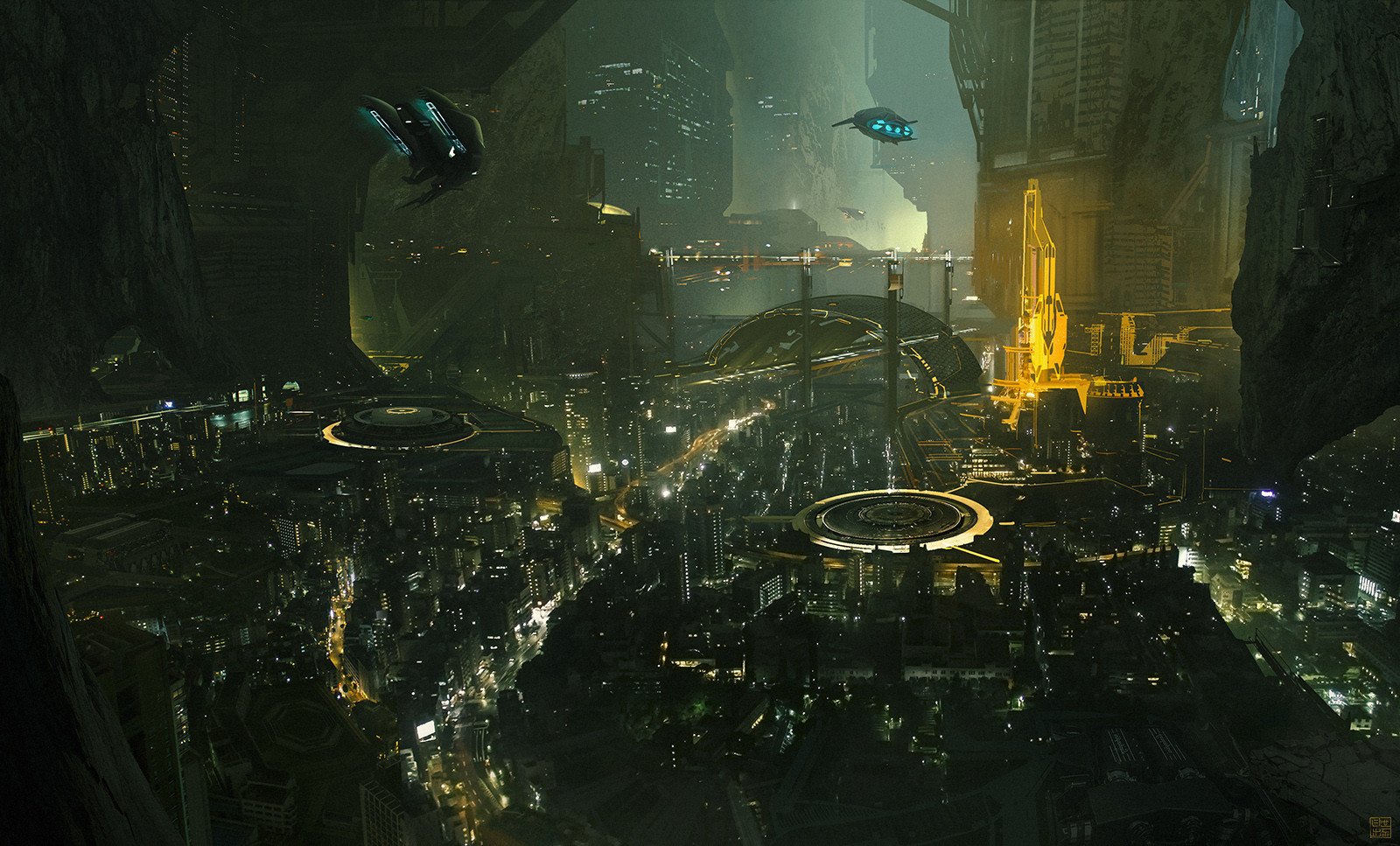
Underground city with flying craft
The leader of the asuras named Taraka was so powerful that he was able to oust the demigods from Mount Meru, taking personal control of the functions of the devas (air, rain, sun, etc). Skanda Purana states:
"All the supernatural powers of all the Devas have been taken away by him [Taraka]. In the form of a great Bhuta (spirit) he alone is Lord of the universe. The moon, the planets, the stars, and others have been dismissed by him, and those belonging to the Daitya-side have been appointed by him in their place." (Skanda Purana, 1.2.22:20-22)
Mount Meru was later retaken by the devas, but this is only one of many instances when the asuras defeated the devas and ruled the entire universe from their administrative seat at Mount Meru. Hiranyakashipu is another famous example; the following account of Hiranyakasipu's power is from Vishnu Purana:
"Hiranyakashipu, the son of Diti brought the three world worlds under his authority, confiding in a boon bewstowed upon him by Brahma. He has usurped the sovereignity of Indra, and exercised of himself the functions of the sun (Surya), of air (Vayu), of the lord of waters (Varuna), of fire (Agni), and of the moon (Chandra). He himself was the god of riches (Kuvera); he was the judge of the dead (Yama); and he appropriated to himself, without reserve, all that was offered in sacrifice to the gods. The deities, therefore, flying from their seats in heaven, wandered through fear of the Daitya, upon the Earth, disguised in mortal shapes. Having conqured the three worlds, he was inflated with pride, and eulogized by the Gandharvas, enjoyed whatever he desired. The Gandharvas, the siddhas, and the snake-gods all attended upon the mighty Hiranyakashipu as he sat at the banquet." (Vishnu Purana, Book 1, Chapter 17)
Srimad Bhagavatam's canto eight, chapter 15, also recounts the history of Bali Maharaja who was able to oust the devas from Mount Meru and rule the universe in their place:
"When the demigods had disappeared, Bali Maharja, the son of Virocana, entered the heavenly kingdom, and from there he brought the three worlds under his control." (SB 8.15.33)
The Earth faced a similar threat from the asuras only five thousand years ago when Lord Krishna along with the Pandavas interceded to destroy the demoniac armies that had amassed on the Earth. The great war culminated in the Battle of Kuruksetra when the last of the demoniac kings were defeated. Some years prior to this event, and before the Rajasuya sacrifice took place in which Yudhisthira was crowned as Emperor of the Earth, the Pandavas had conquered all the kings on the entire Bhu-mandala, and took the submission and tributes of those remaining within the vast depths of the Earth. It should be mentioned that not all asuras are evil, and many alliances were made with Krishna. Krishna actually works for the good of all beings, and indeed the designations of sura and asura are temporary coverings of the modes of nature that momentarily obscure the divine nature of all beings.
In Mahabharata Tatparya Nirnaya, Madhvacharya concludes the particular section of Arjuna's conquest by stating:
"During the conquest, Bhima and other Pandavas had invited all the fourteen worlds. Accordingly Brahma, Rudra, Indra and the entire party had arrived (21.233)."
This verse shows the ancient connection not only between all places upon the Earth's great surface, but also to all realms both below and above the Earth's surface (the fourteen worlds). Yudhisthira's sovereignty of the Earth was acknowledged by all the leaders in the universe who accordingly came to participate in the great Rajasuya yajna:
"In the conference hall of the where the entire universe had primarily gathered, philosophical conferences were held for resolution of truth (tatwaniraaya). Narayana in the form of Shri Vedavyasa who is the embodiment of entire knowledge was the prashnika." (21.236).
THE TRUE EXTENT OF ANCIENT BHARATA-VARSHA
It goes without saying that if the Pandavas had conquered the entire Bhu-mandala, then the tiny area of our known Earth in the form of America, Europe, Asia, Africa, etc., was also part of the ancient Vedic empire. This is a claim that Srila Prabhupada made repeatedly, and can be easily confirmed by archaeological, linguistic, and cultural remnants of the Aryan culture in every part of the world. This is a huge topic and beyond the scope of the present paper, but one can see, for example, that the main symbol of the Aryan civilization, namely the swastika, is found in ancient artifacts from every country in the world. Srila Prabhupada states:
"Parikshit Maharaja belonged to the dynasty of King Bharata. King Bharata, from whose name the Bharatavarsha, the word Bharatavarsha has come. This planet is called Bharatavarsha. This planet, earthly planet, is called Bharatavarsha because it was ruled over by the King Bharata. Gradually, the original Vedic culture lost, Aryan, Aryan family... You French people, you are also Aryan family, but the culture is lost now. So this Krishna consciousness movement is actually reviving the original Aryan culture. Bharata. We are all inhabitants of Bharatavarsha, but as we lost our culture, it became divided. Now it is divided into so many countries: "This is India," "This is France," "This is Germany," "This is this," "This is this." But formerly, the whole planet was known as Bharatavarsha. One culture, Vedic culture, one flag. Now they have increased hundreds and thousands of flags. So actually, if you want United Nations, unity, then you must take this culture, Krishna consciousness, again to become Bharata. That will save the situation." (SB 2.1.5, Paris, June 13, 1974)
In another lecture Srila Prabhupada stresses the same point:
"So Bharata-varsha means the whole planet. But we have lost... Just like we have lost portion of the present Bharata-varsha as Pakistan. Everyone knows, twenty years before there was no such thing as Pakistan. But circumstantially we have lost. So..., so the whole Bharata-varsha has been partitioned as this portion is called America, this portion is called Europe, this portion is called Asia. These are modern names. Actually, the whole planet was Bharata-varsha. And the whole planet was being controlled by Vedic culture. So as we have lost our Vedic culture, as we could not control the others, other people in other part of the world, by our culture, by our political maneuver, we have lost. Even up to the day of Battlefield of Kurukshetra... Why Kurukshetra? Up to the time of Maharaja Parikshit, the whole world was being controlled by one king in New Delhi, Hastinapura. There was no other kingdom. And when the battlefield was..., the battle was there, all people from all parts of body, all parts of the world, they joined, either this party or that party. That was the battlefield." (Bhagavad-gita 2.1, Ahmedabad, December 6 1972)
So according to Srila Prabhupada, the whole world was counted as Bharata-varsha, not just India. In the above lecture Srila Prabhupada includes India as just one of the later divisions. The idea that only India represents Bharata-varsha is mistaken. As Srila Prabhupada says above "We are all inhabitants of Bharata," but the Vedic Aryan culture is now lost. We have "again to become Bharata." Basically every prominent religious center from the ancient world including Delphi, Jerusalem, Rome, Mecca, etc., as well as those on the other continents were ancient Vedic temples that were later destroyed and built over by the iconoclastic religions of Judaism, Christianity, and Islam.
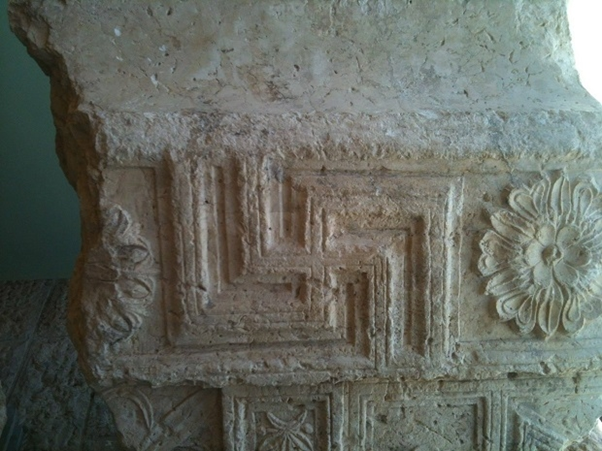
A carved stone with swastika motive from the 2nd Temple (516 BCE and 70 CE) exhibited at the Western Wall compound in Jerusalem
In another lecture Srila Prabhupada states that the true extent of Bharata-varsha is now minimized:
"Krishna came in India and because India is so glorified place, puṇya-bhumi, even the demigods they desire. Not India, this planet, Bharatavarṣa. Formerly, the whole Bharatavarṣa means whole planet. Anyway, for the time it is now minimized." (Morning Walk and Room Conversation -- December 26, 1976, Bombay)
The importance of Bharata-varsha as the place where karma and destiny is created makes it an essential place to control, and since India is the spiritual heart-land of Bharata-varsha, it is not surprising that most of the great events in Mahabharata focused on India. Bharata-varsha, however, expands far beyond India itself. As we shall hear presently, even the whole of our known world is just a small part of Bharata-varsha. In a dialogue with Parvati, Lord Shiva describes the size and location of Bharata-varsha as follows:
"Ishvara said: What is remembered as Jambudvipa is exactly at the center of the Earth. It is divided into nine regions, O beautiful woman, known as the different varshas (regions). Therein the first varsha is Bharata. It is also remembered as being divided into nine parts. From south to north it measures 9,000 yojana (72,000 miles). The distance from east to west is eigthy thousand yojana (640,000 miles). Himavan [Himalaya] is in the north. The Ksiroda (ocean) is in the south. O goddess, Bharata, the excellent ksetra, is in between. There are four yugas, viz. Krta, Treta, Dvapara, and Kali. The division of yugas exists only here. So also the classification of the people into four varnas... The southern-most varsha mentioned by me by the name Bharata has oceans to its south, west, and east. Himavan is to the north like string unto bow. (Skanda-purana 7.1.11.6-13) [book vii: prabhasa kanda, section 1: prabhasa-ksetra-mahatmya, chapter 11, verses 6-13])
So here Lord Shiva says that Bharata-varsha is eighty thousand yojanas (640,000 miles) long. This figure is based on the measurement of the Himalaya Mountain—one of the massive dividing mountains in Jambudvipa that creates a border between one varsha and another (see image above). This figure is confirmed in many Puranas including the Vayu Purana:
"And mountains Himavan and Srngavan are each eighty thousand in length…The two sub-continents in the south [Bharata-varsha] and north (Uttara-kuru-varsha] should be known as situated in the form of a bow" (Vayu Purana:34.24-31)
It is stated here that the length of Himalaya is 80,000 yojana (640,000 miles). Working from measurements given in Srimad Bhagavatam, Sadaputa dasa presents a smaller figure of 480,000 miles; this smaller figure is not in contradiction because the first figure is the length of the mountain as it continues into the sea surrounding Jambudvipa. Sadaputa's figure is the length from coast to coast only. In Vayu Purana it explains how the mountains continue into the sea thus giving a larger figure of 640,000 miles:
"The Kailasha and Himavat are in the south and north. Extending to the east and west they enter the sea." (Vayu Purana 35.9)
The Himalaya is described figuratively as the string of the bow-shaped coast-line of Bharata-varsha. As Shiva described above, the great salt-water ocean surrounds the south, east, and west coast of Bharata-varsha. We can see in the image below how Bharata-varsha has a bow-shaped coast-line (marked in red), with the Himalaya (Himavata) in the north running east to west and forming the string so to speak.
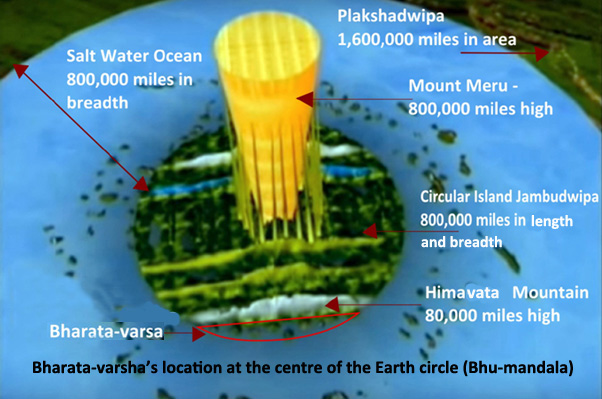
The bow-shaped coast-line of Bharata-varsha
The distance between the Himalaya and the south coast of Bharata-varsha is 9,000 yojana (72,000 miles). Thus Bharata-varsha is 640,000 miles from east to west and 72,000 miles from north to south—a massive area indeed, and obviously far greater than India itself. Not only was India ruled by King Yudhisthira, but all of the rest of Bharata-varsha along with the other varshas of Jambudvipa was under the enlightened rule of this great spiritual emperor. What to speak of Bharata-varsha and the rest of Jambudvipa, the whole of Bhu-mandala was under the control of Yudhisthira.
LESSONS TO BE LEARNT FOR THE TEMPLE OF VEDIC PLANETARIUM
As thus stated in Srimad Bhagavatam and Mahabharata, and as confirmed by Madhvacharya, the Pandavas (by the empowerment of Krishna) conquered the huge realms both on the surface of the Earth and within its vast depths. So what does this tell followers of Vedic literature about the nature of the Earth? It tells followers of the Veda that the idea of Earth as a ball floating in space is completely fabricated, untrue, and an aberration from the Vedanta. The Earth globe idea ranks as perhaps the greatest delusion in history. I bow to the great Maha-maya who creates a world of illusion within a world illusion. May the auspicious appearance of Srimad Bhagavatam in the Western world disperse all such illusions and reveal the truth of the Earth for the spiritual welfare of all:
"Completely rejecting all religious activities which are materially motivated, this Bhagavata Purana propounds the highest truth, which is understandable by those devotees who are fully pure in heart. The highest truth is reality distinguished from illusion for the welfare of all." (SB 1.1.2)
The vast extent of the great Earth circle as well as the awesome potency of superhuman beings like the Pandavas to control such a vast area is beyond the comprehension (what to speak of admittance) of those who are envious at heart, who—like Duryodana—burn with envy at the true nature of Krishna's amazing Earth circle along with His exalted devotees who are engaged in governing and maintaining it. By limiting people's perception of the Earth to a small globe floating in space, those of asuric nature are better able to set themselves up as lords and masters of the so-called 'planet.' In order to keep people in ignorance of the real facts one has to control their perception. In the Kali-age which is practically devoid of truth, the mere perception of what is real becomes accepted as the fact! Thus, due to the wonderful workings of maya, the asuric forces can employ pseudo-science and false images to create the perception or belief that the Earth is a small globe floating in space. They thereby keep everyone in a very narrow and controlled perception of what exists, and what is real, and, of course, with no way for anyone to question the nature of the illusion since any talk of God or the soul, what to speak of the flat-Earth, is mercilessly ridiculed via the propaganda channels of media and education. We can take it for certain that (as in the past) every attempt will be made in the present to ridicule, corrupt, and prevent the true nature and history of the Vedic Earth from becoming known.
Unfortunately, we have thus far been presented a complete misunderstanding of the Bhu-mandala concept by those members of ISKCON engaged in researching Vedic cosmology on behalf of the Temple Of Vedic Planetarium (TOVP); for the present, therefore, we do not expect to see any real counter challenge to the dominant globe concept coming from within the TOVP itself.
The image below, for example, presented by a mis-informed TOVP representative, shows Bhu-mandala tragically depicted as impersonal rings in dark space. I mean no disrespect to the devotee responsible for such an image, but it must be pointed out that the image not only fails to depict the Bhu-mandala as a vast solid ('earthy') landscape, but also gives an entirely wrong idea of the Bhu-mandala as some nebulous formation floating in dark space:
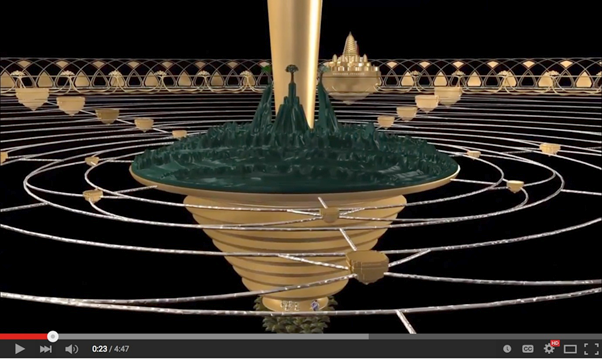
A misinformed depiction of Bhu-mandala
The above depiction presented by the Temple Of Vedic Planetarium (TOVP) has just obliterated any idea that the Bhu-mandala is simply one continuous landscape wherein countless billions of living beings reside with their various habitats and culture. This misleading concept of Bhu-mandala (Earth circle) couldn't be any further from the truth, and serves only to misinform people of Srimad Bhagavatam's real message about the Earth—namely that our own area of the Earth is only a tiny part of the greater Earth circle that surrounds us in all directions. The Earth's landscape by definition is 'earthy' not 'spacey'. Since an island is comprised of solid land and an ocean is comprised of water; the actual reality of Bhu-mandala's seven islands and oceans would look more like this:
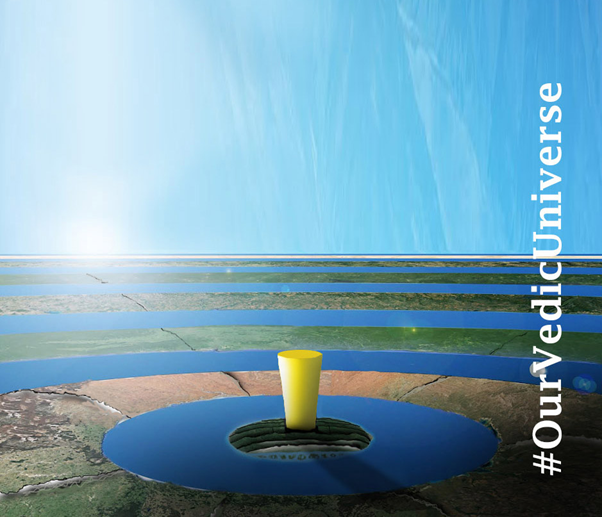
Part of the Bhu-mandala's inhabited landscape consisting of seven islands and oceans in the form of concentric circles
The Earth circle is one continual inhabited landscape formed of a series of massive circular islands and oceans; it is not a collection of impersonal rings suspended in dark space. Despite whatever speculation will eventually emerge from the TOVP, the Vedic history of the Pandavas controlling the vast Bhu-mandala should lead the truthful Aryan community to bring about a complete rewriting of world history, as well as a complete overthrow of present misconceptions and illusions surrounding the nature and extent of the Earth. The great problem that Aryans encounter is that India itself has fallen victim to Western cosmological ideas regarding the nature of the Earth, Sun, and Moon. The prevailing mentality among India intellectuals writing on cosmology is to try and show the advancement of ancient Vedic knowledge by propagating the idea that the Vedas also describe Earth as a globe floating in space. They thereby end up practically adopting the whole Western cosmological system in toto. The same mistake pervades the writing of certain members of ISKCON who also pertain to be presenting Vedic cosmology.
Although Srila Prabhupada also argued that the Vedic name bhu-gola (round earth) refers to the Earth globe and thus demonstrates the superior understanding of the ancient Vedic sages, his reasons for doing so have to be carefully understood; we refer the reader again to our previous paper entitled, "Why Did Srila Prabhupada Call the Earth a Globe? " The paper can be found here.
We have not yet compiled all of Srila Prabhupada's mostly negative statements in regards to the 'flat-Earth' concept, but an introductory explanation for Srila Prabhupada's position on this question can be found here.
At the first opportunity we hope to prepare further papers compiling and explaining (in context) all of Srila Prabhupada's statements using the words 'flat-earth.' These statements are otherwise, generally quoted out of context by supporters of the globe, and without showing any sign on the person's part of having any knowledge or understanding of the flat Earth (Bhu-mandala) as it is described in the various Puranas. We request the devotee community to bear in mind Srila Prabhupada's own statement regarding the Vedic and modern astronomical ideas about the universe:
"There are so many things to be known still from Vedic literature, it is not yet unfolded, but we are trying." (SB 7.9.8, Mayapur, February 15, 1976)
Rather than simply accepting accounts in the Puranas as a factual description and history of the greater Earth circle, those within ISKCON who have so far presented the Earth as a globe, do so only in the face of the actual descriptions of Bhu-mandala contained in the Puranas—descriptions which paint a very different picture. Having begun with the initial self-assured assumption/faith/belief that the science and images confirming an Earth globe are factual, they are thereby unable to account for the absence of the rest of Bhu-mandala in such a paradigm. Where, for example, is the rest of Jambudvipa in NASA's so-called images of the Earth? But rather than doubting the authenticity of images of the so-called Earth globe, the so-called experts in Vedic cosmology have placed their faith in the modern paradigm, and duly concocted an entire speculation that attempts to reconcile the utterly opposed Western and Vedic conceptions of the Earth.
Despite clear descriptions of Bhu-mandala as a vast circular disc with the sun and moon rotating above the Earth plane, the speculators simply corrupt this understanding by superimposing the Western idea that the Earth is a small globe. Please bear in mind that the modern presentation of the Earth as a small globe circling around the sun began with Copernicus, Galileo, Kepler, etc, and makes absolutely no reference to, or has any similarity with the Vedic conception.
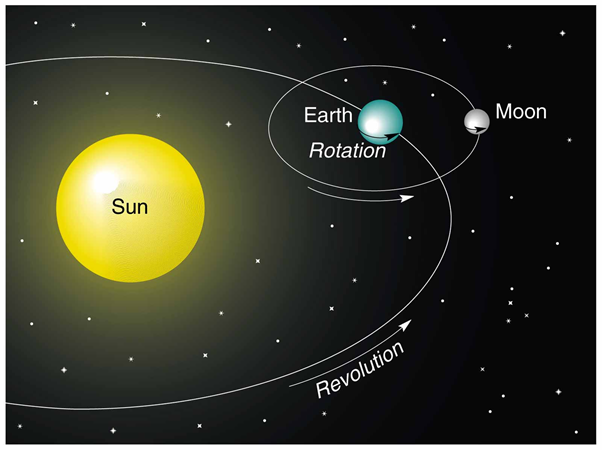
The modern idea of the movements of Earth, Sun and Moon
Members of ISKCON who work from this presumed model of reality, then attempt to reconcile the Vedic and modern conceptions of the Earth by trying to integrate and harmonize this initial speculation with the original Bhu-mandala conception. Rather than questioning the original foundation of modern cosmology, they feel the need to make the Bhu-mandala concept 'fit in' with modern cosmological ideas. The result, however, is that they thereby drastically change the original description and meaning of the Earth as it is found in Srimad Bhagavatam.
In the modern conception, the Earth is a small globe floating in space with a diameter of 24,900 miles. The Srimad Bhagavatam, by contrast, describes Earth as a circular disc with a diameter of 4 billion miles spanning the entire center of the universe and held up by Ananta-sesha. According to the description in the Puranas, day and night are created by the sun as it rotates above the flat plane of Bhu-mandala. The image below is looking down upon the flat-Earth plane with the seven islands depicted in the formation of concentric circles. As the sun circles around the Bhu-mandala at a distance of 800,000 miles above the surface it creates day on one side of the Bhu-mandala and night on the other:
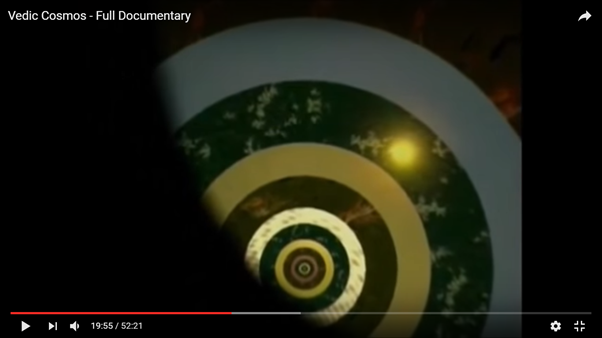
The sun creating day and night on the Vedic flat-Earth
As is stated in Srimad Bhagavatam:
"People living in countries at points diametrically opposite to where the sun is first seen rising will see the sun setting, and if a straight line were drawn from a point where the sun is at midday, the people in countries at the opposite end of the line would be experiencing midnight. Similarly, if people residing where the sun is setting were to go to countries diametrically opposite, they would not see the sun in the same condition" (SB 5.21.8)
Speculations have emerged from ISKCON representatives writing on Vedic cosmology that the above verse is proof of on an Earth globe with the sun creating day and night on opposite sides of the globe. However, the verse has absolutely nothing whatsoever to do with the effects of the sun on a so-called Earth globe. The verse is describing the movements of the sun as it orbits the entire Bhu-mandala which has been thoroughly described in the preceding chapters of the fifth canto cosmology section spoken by Sukadeva Goswami in reply to Pariksit's question regarding the 'names', 'measurement', 'form', and 'characteristics' of the Bhu-mandala (see SB 5.16.1-4). The name Bhu-mandala is specifically invoked.
By comparing the descriptions between the modern and Vedic conceptions of the Earth as shown above, a follower of Srimad Bhagavatam can quickly conclude that the idea of a small Earth globe floating in space is not a Vedic concept. The modern system of thought arose out of the speculations of Copernicus, Galileo, etc. Whether one accepts them as real or not, the fact is that this model of the planets has nothing whatsoever to do with the original Vedic description of the movements of the Sun and Moon above the vast stationary Earth plane; and thus there is nothing for the Temple of Vedic Planetarium to reconcile in an unabashed presentation of Bhu-mandala as a factual description of the Earth. Since the two systems of thought are completely opposed, what requires to be done is not a reconciliation of Vedic and modern ideas of the Earth, but rather, to show the falsity of the modern Earth globe paradigm. A huge world-wide flat-Earth movement is already busy deconstructing the so-called 'science' and propaganda that supports the globe belief. ISKCON is the society responsible for presenting Vedic cosmology via the TOVP and should argue unreservedly that the images produced by NASA of an Earth globe floating in dark space are fake (as can be clearly demonstrated), and have created a false construct of reality.
The International Society of Krishna Consciousness (ISKCON) has been delegated by its Founder-Acharya, His Divine Grace A.C. Bhaktivedanta Swami Prabhupada with the task of building the Mayapur Temple of Vedic Planetarium for the purpose of presenting the cosmology of Srimad Bhagavatam. It is, therefore, incumbent upon the members of the society and particularly those responsible for the exhibits within the Temple of Vedic Planetarium itself, that they understand and present the Earth as it is described in Srimad Bhagavatam—that is, a great circular flat plane held up by Ananta-shesa, not a small round globe floating in space. Nor can they hope to satisfy everyone by including an argument for both conceptions to exist simultaneously. The description must be depicted and explained as it originally appears in the text. The Vedic flat-Earth is a great circular plane that crosses the center of the universe dividing the universe into higher, middle, and lower modes of nature. Our known Earth area known as Bharata-varsha is just one tiny section on this huge circular landscape. This is the truth as presented in Srimad Bhagavatam and this is the knowledge that should be presented to the world via the Mayapur Temple of Vedic Planetarium.
Unlike the globe paradigm which depends on a highly spurious second party like NASA or the ESA for verification of the shape of the Earth, the flat-Earth is something that anyone can prove for themselves. With a decent camera one can take infrared photos of surrounding land that can be many hundreds of miles away, but which according to globe theory should be under the curve of the globe and impossible to see from such a distance. The surface of the Earth is observably and measurably flat. Water levels in lakes and oceans covering hundreds and thousands of miles also prove that the Earth is flat. As one travels, sails, or flies over the surface of the Earth, one travels over a horizontal plane from edge of the Earth to the other. Save NASA's images of the so-called Earth globe, there is no observable or measurable curve that one can detect from the sky or on the ground.

Numerous tests involving lasers and infrared cameras show that the Earth is observably a continual flat plane
From the Vedic history we can understand that there is more Earth around us (as recounted in the conquest of Bhu-mandala by the Pandavas). The Vedic flat-Earth has a diameter of 4 billion miles, and stops a few hundred thousand miles short of the shell of the universe. Following this description, we can reassure the skeptics that one doesn't fall off the edge of the flat-Earth (the predictable guffaw response to the flat-earth concept); rather, our known Earth simply continues into other parts of Bhu-mandala. We are currently prevented from accessing these other parts of Bhu-mandala by the higher power of daiva:
"Every living entity is controlled by a supernatural force (daiva-adhineshu) and thus his sense enjoyment (kameshu) is also under the control of that supernatural force (daivadhinah)" (SB 3.3.23)
The present generation are thus tethered, and made to move in circles around the limited area of our known Earth. For the present, therefore, knowledge and experience of the surrounding flat-earth is ascertained only from shastra.
kavibhih shastra-cakshusa Learned scholars see through the eye of scripture (SB 10.84.36)
Of course, words from ancient scriptures are hardly a satisfactory answer for the atheists and empiricists who only believe what they can see and touch with their immediate senses; but for those who understand the spiritual science, who have faith in the Vedas, and who don't wish to take any chances with future births (either on or within the great Earth circle), the description of other lands surrounding our own is accepted as factual.
Immediate ground can be gained for the Bhu-mandala concept by concentrating all the Vaishnava forces on a major deconstruction of the propaganda and so-called 'science' from which the Earth-globe paradigm has been created. By exposing the contradictions, mistakes, speculations, cheating, and deception that supports this false construct of reality, the people will be able to see for themselves that what they thought was the world (the Earth-globe) is really just a world of illusion within a world of illusion.
In Part 2 of this paper we will look at the flat-Earth history in Ramayana.